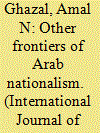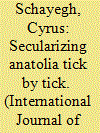|
|
|
Sort Order |
|
|
|
Items / Page
|
|
|
|
|
|
|
| Srl | Item |
| 1 |
ID:
094819


|
|
|
|
|
| Publication |
2010.
|
| Summary/Abstract |
As editor of IJMES from 2004 to 2009, I spent the last five years in the catbird seat of Middle East studies, where I had the privilege of reading well over 500 article submissions that flowed into the editorial office, some 100 of which were ultimately destined for publication. I characterize the experience as very gratifying on the whole; ours is a field that has attracted talented and skilled scholars who are doing some very creative work-this is not a change per se, although it can be argued that we have a new generation involved in increasingly more theoretically informed projects. Have there been other, more tangible, developments in the field as reflected in submissions to IJMES? I mention four trends I have spotted over time that may suggest some of the recent shifts-in region, topic, scope, and critical engagement-in research foci.
|
|
|
|
|
|
|
|
|
|
|
|
|
|
|
|
| 2 |
ID:
094821


|
|
|
|
|
| Publication |
2010.
|
| Summary/Abstract |
The last century of the Ottoman Empire saw an intense move to build clock towers in Anatolia. Among the reasons for this move were the central government's desire to advertise its sovereignty in the provinces, its desire to secularize the same periphery, and that clock towers were a means for Christians to erect church towers. Compounding this already complex layering of meanings, these towers were often erected under the pretext that they would help announce the daily times of prayer. After the proclamation of the Turkish Republic in 1923, this move continued in a new guise: clock towers were attached to modern-style buildings that advertised the republican project. Using documents from the Archives of the Prime Ministry and other primary sources, this paper attempts to trace the proliferation of clock towers in Anatolia and how the meanings attached to these edifices changed through time.
|
|
|
|
|
|
|
|
|
|
|
|
|
|
|
|
| 3 |
ID:
094822


|
|
|
|
|
| Publication |
2010.
|
| Summary/Abstract |
In Egypt, during the late 19th and early 20th centuries, older, fragmented, and more localized forms of identity were replaced with new, alternative concepts of community, which for the first time had the capacity to collectively encompass the majority of Egyptians. The activism of Mustafa Kamil (1874-1908) and the populist message of the Watani Party began the process of defining and popularizing urban Egyptian nationalism. After Kamil's premature death in 1908, there was more of an "urgent need," as described by Zachary Lockman, for "tapping into and mobilizing new domestic constituencies in order to build a more broadly based independence movement." This article argues that the eventual mobilization of the Egyptian urban masses, and their "incorporation into the Egyptian nation," was due in large part to the materialization of a variety of mass media catering to a growing national audience. To be more specific, I will examine early Egyptian nationalism through the lens of previously neglected audiovisual colloquial Egyptian sources. This, I argue, is crucial to any attempt at capturing the voice of "ordinary" Egyptians. Finally, the article documents the role of early colloquial Egyptian mass culture as a vehicle and forum through which, among other things, "hidden transcripts" of resistance and critiques of colonial and elite authority took place.
|
|
|
|
|
|
|
|
|
|
|
|
|
|
|
|
| 4 |
ID:
094823


|
|
|
|
|
| Publication |
2010.
|
| Summary/Abstract |
The historiography of Arab nationalism has tended to concentrate on the secular press from the Mashriq, especially the Cairo-Beirut axis, at the expense of the religious nationalist press and the non-Mashriqi one. There is often an assumption that reliance on the secular press from the Mashriq alone can provide a clear picture of Arab intellectual life and that a proper analysis of that thought can be confined to a few intellectual centers in the eastern Arab world. Although there has never been an explicit claim that such a focus is the end of the story, there have not been enough attempts to look beyond the Cairo-Beirut axis and beyond its secular press organs in search of a broader story of the depth and breadth of Arab nationalism. This article addresses this imbalance by examining an Arabist-Salafi press network that operated between Algeria, Tunisia, Zanzibar, and Egypt and involved members of two sectarian communities, Sunnis and Ibadis. This Arabist-Salafi press network created a public sphere of intellectual engagement in which Salafism and nationalism were interwoven, producing a nationalist discourse transgressing post World War I borders of identity and linking the three layers of nationalism-the territorial, the Pan-Arab, and the Pan-Islamic-together. These layers not only intersected but also legitimized one another.
|
|
|
|
|
|
|
|
|
|
|
|
|
|
|
|
| 5 |
ID:
094824


|
|
|
|
|
| Publication |
2010.
|
| Summary/Abstract |
Rapid population growth constitutes one of the most critical problems confronting many Middle Eastern and North African countries, placing incremental pressure on their finite water and other natural resources and challenging their abilities to grow sufficient food, accommodate school and university graduates with jobs, build adequate urban and rural infrastructures, contain rapid urbanization, and alleviate poverty, illiteracy, malnutrition, and disease. More than one-third of the population is under the age of fifteen in a majority of countries and, thus, has yet to marry and reach reproductive age. As a result, in most places the number of women of childbearing age (fifteen to forty-nine) will more than double in the next thirty years. Because there are so many young people, by one estimate the region's economies would have to generate half as many additional jobs by 2010 as existed in 1996 to avoid an increase in already high unemployment rates, particularly among young adults. The growing bulge of unemployed young people has serious political ramifications for many Middle Eastern regimes, from Algeria to Saudi Arabia. These problems will likely get worse in the short term because of demographic momentum-the parents of the future have already been born.
|
|
|
|
|
|
|
|
|
|
|
|
|
|
|
|
| 6 |
ID:
094820


|
|
|
|
|
|
|
|